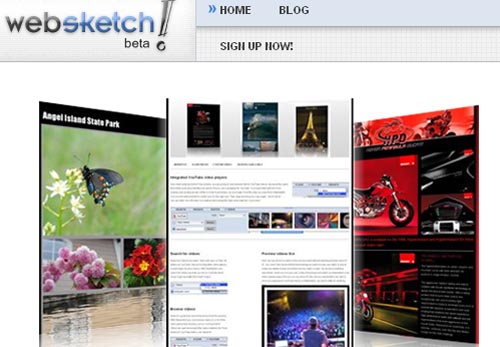as an attention grabbing alternative OS that runs in a browser. After all, it could be argued Firefox is a kind of operating system that runs JavaScript apps. EyeOS makes easy work of common tasks like file associations and one-click access to your favourite apps. The OS includes 60 popular apps, including word processing and audio players – you can get more at
. Still in its infant state, EyeOS reveals a tantalising glimpse of what Windows could look like if it ran in a browser.
pulls it off. You can enter vast quantities of data – the entire fantasy football roster for all your friends, for example – and then share the data between Blist users. Templates are geared for those who want to weed out duplicate data.
The holy grail of file syncing is the ability to drop files into a folder and have that same folder show up on every other computer you own and work exactly like a network drive – except that it's online.
(still in beta) solves this issue. Just add a folder to your desktop and copy files. You can also share complete folders so that anyone with access to the folder sees and is able to use the shared, synced files.
is a unique online back-up utility that sits in your system tray and watches important folders, such as those containing 'dev' files or Word documents, automatically archiving them to a secure website as you work. There is no limit to the storage space available, although the program will only upload a couple of gigabytes per day. Strangely, after install, the clientside app reboots Windows Explorer.
– the main draw is that the site houses over 7,000 fonts, all freely available to download for Mac or Windows. Linux users will have to convert the fonts. You can grab every single font in one eMule or BitTorrent file; just go to www.dafont.com/faq.php#howmany and look for the 'zip' file links.
proves that Adobe is on a clear path toward online apps. It's fairly basic: you can apply a handful of filters for lighting and exposure, rotate and re-size images, embed photos into a web page and share your shots with other users – even those on Flickr. The site shows huge potential: with 2GB of free storage, imagine being able to apply complex editing tasks to a series of photos where 'the cloud' does all the processing for you.
There's a plethora of general purpose how-to sites on the web, including the fantastic
is for the technical-minded Photoshop user. You may already know how to perform a Gaussian blur, but Luxa teaches you how to make neon glow effects, complex layering, text design within Photoshop and many other skills.
just because it's owned by AOL: the site is an example of how the web can be a powerful ally in digital media collection. You can upload music, photos, and videos. The handy status bar lets you do a massive bulk upload and switch to a different tab, then check back to see how much data has been uploaded.
22. Ecommerce sites have changed dramatically over the years.
Imagekind is a unique site that lets you preview museum art and photos on various picture frames and even different canvas materials before making the purchase. Prints generally cost about £15 each. You can also sell your own prints.
23. Web users are always in a hurry, which is what makes
Flauntr so attractive. You can click one option to see multiple views of how a filter will change your photo. Using the 'PicasR' filter, you can pick a work of art from Picasso and apply that technique to your image. The site isn't exceptionally fast, but the drag-and-drop interface and one-click effects are worth exploration.
24. If registering with
Simplebucket could be easier, we'd be surprised. To upload photos (2MB max per image), you don't even need an account. You just type in your email, select photos and upload. You can then view those photos associated with your email account by clicking on a secure link the site sends you. Simplebucket is free, although you can buy more 'upload credits' for a few dollars – you get five free per day. If you want a password, you can always upload a photo and then click 'Settings' to create an account.
25. 1001freefonts actually has about 7,000 fonts to pick from, each with a useful preview. You can also perform a 'custom preview' to see how the font looks with the text you intend using. There's also a download option to buy 7,000 fonts all at once, which costs about a tenner.
26. InterfaceLIFT is a vast collection of icons, images, wallpapers and random clipart, which can help you add some flair to a web app or an interface. You can also just download desktop wallpapers — it's an amazingly good collection and all the artwork is free to use.
27. Similar to Photoshop Express,
Picnik goes much further with an extensive array of photo-editing effects, histograms, fine pixel alterations and colour correction. You can upload photos from your PC, a webcam and any website.
Research and e-learning
28. Not all sites have to use a flashy interface.
Martindale's reference desk is essentially a collection of links to really useful information. There's a huge wealth of reference material on disparate topics such as banjo lessons, world clocks, time and expense calculators, eye tests for computer users, a science database, currency convertors and just about anything you can think of. As the web moves closer to a 'single use' model where one site performs only a simple function, Martindale's throws the book at you – virtually.
29. Ever wonder how to embed a picture to a cell in Microsoft Excel? At
eHow, you can find the answer in just a few clicks. They have categories for electronics, careers, health and many others. The site is almost all text, so you can find the answers you need quickly.
30. Mashery is a hosted service for your web API – it allows you to create links between, say, Yahoo! maps and Flickr photos, or plot the location of public parks with disc golf data you pull from a volunteer site. It supports usage tracking, asset management, encryption – everything you need to link data form one host to another.
31. Amazon uses the term 'artificial artificial intelligence' (sic) to define what the
Mechanical Turk site is all about. It's actually a site where you can sign up to perform very repetitive tasks, such as typing text transcripts for videos. You pay just a few cents per completed Human Intelligence Task. These are generally things that a computer is not very good at. It's a very illuminating example of where AI is faltering.
32. Agreeing on basic business principals often requires written contracts and lawyers. You can skip that chaos by using
Mumboe, a site that hosts online applications for business agreements. The free account is quite limited: you can only host up to 10 agreements and only three users can apply. Pricing for premium accounts runs to about £12 to £24 per month for unlimited users, secure and searchable contracts and version control. Registration is a little clunky: you have to agree to the terms twice and the confirmation email took a while to send.
33. Not quite a web aggregator, yet more than a simple search engine,
PageOnce lets you add secure sites to one page – you can see your bank balance, airline ticket info, Netflix rentals and a host of other data. Registration was pretty easy: no codes to type in, just a confirmation link sent through email.
Mobile workers
34. The problem with most video chat software is that everyone you chat with needs to have downloaded the client.
TokBox works online for two-way chats and multi-point video conferences with no software to download, and the registration is Web 2.0-streamlined to get you talking straightaway.
35. Other online conversion sites show you a laundry list of other options besides currency, for example weight, measurement and even language.
Xe focuses entirely on currency, which means that it's easier to navigate and conversion options are all on the main screen.
36. While many online flight search sites are US-only,
Skyscanner lets you choose any country as your origin, supports many different languages and presents an uncluttered, mostly ad-free interface for finding the lowest rates on international flights.
37. A web whiteboarding tool,
Twiddla lets you visit any site and then host a meeting online where you can chat about the site, host an audio chat and mark it up with shapes and notes to participants. It's very useful for web developers and designers who want to visit a site in production to talk about the look and feel of it. It's also just a good meet-up site for mobile users who need to exchange ideas, and best of all, it's free.
38. Mobile users can watch TV any time they want with
Joost - and the service has recently switched to an online viewer instead of requiring that you download a client. With 28,000 shows online, Joost has a leg up on other more 'premium' sites such as
Hulu, although don't expect a high bit-rate or HD quality for any of the online streams.
39. Vello is unique. It lets you arrange a phone conference by calling a Vello number that re-distributes the conference call number to anyone that you want. There's no registrationor sign-up for attendees, and the site even offers a seven-day free trial to check it out.
40. Instant messaging aggregators are handy because they put all of your accounts into one page so you can chat with your associates and friends without installing any software.
Orgoo is helpful if you tend to visit Internet cafes or use a borrowed laptop from work, or just want one-click access to IM. Still in private beta, it also offers a new video chat service that uses your webcam and is now open for unregistered use.
41. Like an open-source version of Microsoft Exchange,
Zimbra is a mail client for business use where you host all of the mail online for every user. You can share all of your personal folders, assign specific tasks to certain people, instant message, integrate IMAP and POP mail as well as use an iPhone client to access the mail repository, and arrange meetings with your team.
42. Note-taking apps are usually small utilities that you download and use on your desktop.
Evernote is a webbased version that collects all of your fragmented data into one searchable portal. You can scan documents, send an email to your account and upload photos, videos or just about anything you can think of to your own secure site. Then, when you need to find that one website or phone number, or that hilarious photo from the last business outing, you can fi d it on the free notes database online.
Miscellaneous
43. Keepm is a business card manager for the web. Adding a contact is very quick: you type the name, then add the phone numbers and address for that person. You can also import data from Outlook or using a the vCard file format and you can export your contacts database for use in other programs as a vCard or CSV file.
44. It's about time someone created an aggregator for video content.
OVGuide doesn't actually host any videos, but it helps you find where they are located on the web. It's agnostic about the legalities of full-length feature films, merely pointing you to known locations.
45. Weeding out the undesirables and trolls on Internet forums is a Herculean task.
Daniweb is a different kind of IRC chat: only IT professionals can join and the chats tend to be highly technical rather than just mindless chatter.
46. Google searches are a million miles wide and a centimetre thick.
Stumpedia only returns the results that other users think are valuable. We searched for virtualisation on both search engines. On Google, we saw millions of links, most of them poorly worded definitions and myopic marketing sites. On Stumpedia there are just three links, including a site entry that does the server technology justice – it's worth a click.
47. The brilliant thing about trip planning site
TripIt is that it knows where you are. If you plan a business trip to London, you can load all of your contacts from email clients and then track who will be in the area at the same time as you.
48. Intense – that's the initial reaction we had when using
TunesBag (still in private beta – you have to request an invitation). Legal because the site is hosted in Austria, you can upload all of your music files to the site and then listen to the songs from any computer – or share the music with anyone you want. Use it while it's still alive!
49. If you use an RSS reader then it's worth checking out
Toluu. The site is an 'aggregator of the aggregators'; you can import multiple RSS feeds from various sources and read them all in one spot before sharing the feeds with other users. Sharing is key: it means that you see what people who have subscribed to the same feeds as you are reading.
50. SoSauce is a catch-all for journaling to yourself (reminders, thoughts for the day), finding travel deals, social networking with other users and sharing photos. We love the area where you can play games like extreme sledding and hyper pong against other SoSauce members. (via
tech radar)
 Daily habits can affect our well-being. Here are 10 simple actions that research has shown makes people feel good.
Daily habits can affect our well-being. Here are 10 simple actions that research has shown makes people feel good. 


















































